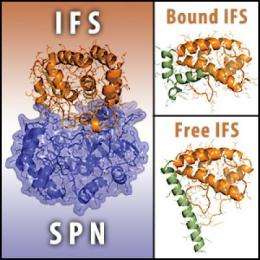Turning bacteria against themselves

Bacteria often attack with toxins designed to hijack or even kill host cells. To avoid self-destruction, bacteria have ways of protecting themselves from their own toxins.
Now, researchers at Washington University School of Medicine in St. Louis have described one of these protective mechanisms, potentially paving the way for new classes of antibiotics that cause the bacteria's toxins to turn on themselves.
Scientists determined the structures of a toxin and its antitoxin in Streptococcus pyogenes, common bacteria that cause infections ranging from strep throat to life-threatening conditions like rheumatic fever. In Strep, the antitoxin is bound to the toxin in a way that keeps the toxin inactive.
"Strep has to express this antidote, so to speak," says Craig L. Smith, PhD, a postdoctoral researcher and first author on the paper that appears Feb. 9 in the journal Structure. "If there were no antitoxin, the bacteria would kill itself."
With that in mind, Smith and colleagues may have found a way to make the antitoxin inactive. They discovered that when the antitoxin is not bound, it changes shape.
"That's the Achilles' heel that we would like to exploit," says Thomas E. Ellenberger, DVM, PhD, the Raymond H. Wittcoff Professor and head of the Department of Biochemistry and Molecular Biophysics at the School of Medicine. "A drug that would stabilize the inactive form of the immunity factor would liberate the toxin in the bacteria."
In this case, the toxin is known as Streptococcus pyogenes beta-NAD+ glycohydrolase, or SPN. Last year, coauthor Michael G. Caparon, PhD, professor of molecular microbiology, and his colleagues in the Center for Women's Infectious Disease Research showed that SPN's toxicity stems from its ability to use up all of a cell's stores of NAD+, an essential component in powering cell metabolism. The antitoxin, known as the immunity factor for SPN, or IFS, works by blocking SPN's access to NAD+, protecting the bacteria's energy supply system.
With the structures determined, researchers can now test possible drugs that might force the antitoxin to remain unbound to the toxin, thereby leaving the toxin free to attack its own bacteria.
"The most important aspect of the structure is that it tells us a lot about how the antitoxin blocks the toxin activity and spares the bacterium," says Ellenberger.
Understanding how these bacteria cause disease in humans is important in drug design.
"There is a war going on between bacteria and their hosts," Smith says. "Bacteria secrete toxins and we have ways to counterattack through our immune systems and with the help of antibiotics. But, as bacteria develop antibiotic resistance, we need to develop new generations of antibiotics."
Many types of bacteria have evolved this toxin-antitoxin method of attacking host cells while protecting themselves. But today, there are no classes of drugs that take aim at the protective action of the bacteria's antitoxin molecules.
"Obviously they could evolve resistance once you target the antitoxin," Ellenberger says. "But this would be a new target. Understanding structures is a keystone of drug design."
More information: Smith CL, Ghosh J, Elam JS, Pinkner JS, Hultgren SJ, Caparon MG, Ellenberger T. Structural basis of Streptococcus pyogenes immunity to its NAD+ glycohydrolase toxin. Structure. Feb. 9, 2011.
Provided by Washington University School of Medicine















